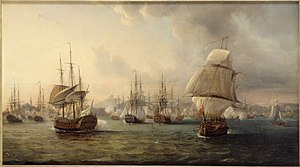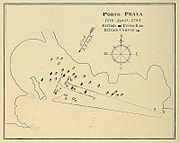
The Battle of Sadras was the first of five largely indecisive naval battles fought between a British fleet and a French fleet off the east coast of India during the Anglo-French War. Fought on 17 February 1782 near present-day Kalpakkam, the battle was tactically indecisive, but the British fleet suffered the most damage. Under Suffren's protection, French troop transports were able to land at Porto Novo, present-day Parangipettai.

Annibal was a 74-gun ship of the line of the French Navy, lead ship of her class. She was designed by Jacques-Noël Sané, and was one of the earliest of his works. She was built at Brest in 1778.
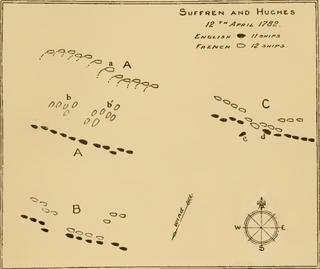
The Battle of Providien was the second in a series of naval battles fought between a British fleet, under Vice-Admiral Sir Edward Hughes, and a French fleet, under the Bailli de Suffren, off the coast of India during the Anglo-French War. The battle was fought on 12 April 1782 off the east coast of Ceylon, near a rocky islet called Providien, south of Trincomalee.
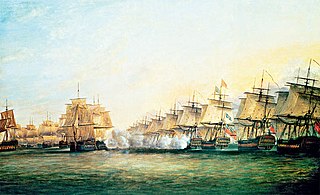
The Battle of Trincomalee was fought between a British fleet under Vice-Admiral Sir Edward Hughes and a French fleet under the Bailli de Suffren off the coast of Trincomalee, then Ceylon, on 3 September 1782. It was the fourth in a series of battles fought between the two fleets off the coast of the Indian subcontinent during the American Revolutionary War.

George Johnstone was a Royal Navy officer who saw service during the War of the Austrian Succession, the Seven Years' War and the American War of Independence, rising to the rank of post-captain and serving for a time as commodore of a British naval squadron. In a multifaceted career he was also a member of parliament, a director of the East India Company, a member of the Carlisle Peace Commission and the first Governor of West Florida from 1763 until 1767.

Héros was a 74-gun ship of the line of the French Navy, known mostly for being the flagship of Pierre André de Suffren de Saint Tropez during the Anglo-French War.
HMS Hannibal was a 50-gun fourth rate ship of the line of the Royal Navy, built by Adams of Bucklers Hard and launched on 26 December 1779. The French ship Héros captured Hannibal off Sumatra on 21 January 1782.

Artésien ('Artesian') was a 64-gun ship of the line of the French Navy, lead ship of her class. She was funded by a don des vaisseaux donation from the Estates of Artois.

Admiral comte Pierre André de Suffren de Saint Tropez, bailli de Suffren, Château de Saint-Cannat) was a French Navy officer and admiral. Beginning his career during the War of the Austrian Succession, he fought in the Seven Years' War, where he was taken prisoner at the Battle of Lagos. Promoted to captain in 1772, he was one of the aids of Admiral d'Estaing during the Naval battles of the American Revolutionary War, notably taking part in the Siege of Savannah.

The Battle of Saldanha Bay was a naval action that occurred off the Dutch Cape Colony on 21 July 1781 during the Fourth Anglo-Dutch War. A squadron of Royal Navy warships under the command of commodore George Johnstone captured five Dutch East India Company ships; her own crew destroyed a sixth. Casualties on the Dutch side were minimal if any, and there were no British casualties.
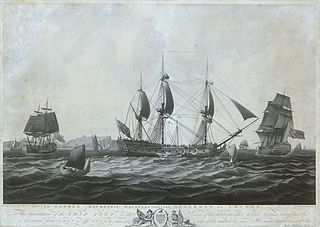
Fortitude was a merchant vessel built in 1780 on the River Thames. A French frigate captured her in 1782 while she was on the return leg of her maiden voyage to India as an East Indiaman for the British East India Company (EIC). However, the British recaptured her in October 1782. The EIC purchased her and sent her back to England. There, in 1785, George Macartney Macauley purchased her and renamed her Pitt. She then performed five voyages for the British East India Company (EIC) between 1786 and 1798. In between, she made one journey transporting convicts from England to New South Wales. She was broken up in 1801.
Pierre Servan René Bouvet de Maisonneuve was a French naval officer. He served in several notable battles, notably the action of 17 June 1778, and the battles conducted by Suffren in the Indian Ocean. He was wounded at the Battle of Porto Praya. He was the father of Pierre François Étienne Bouvet de Maisonneuve.

The action of 10 September 1782 was a minor engagement between five merchant vessels — four East Indiamen of the British East India Company and a country-ship — on the one side, and a French frigate on the other. The action resulted in only a few casualties and was inconclusive. What was noteworthy was that the Indiamen sought out the French man-of-war and attacked it; it would have been more usual for the merchantmen to have avoided combat as they had little to gain from a battle.
Hinchinbrooke was the Spanish ship San Carlos that Admiral Rodney's squadron captured on 8 January 1780. She was sold as a prize and in 1781 commenced a voyage as an "extra" ship of the British East India Company. During the voyage a French squadron captured her at the Battle of Porto Praya, but the British Royal Navy recaptured her within a day or so. She was lost in the Hooghly River in 1783 on her return voyage to Britain.
Fine was a Sybille class 32-gun, copper-hulled, frigate of the French Navy.
HMS Fortune was a British 14-gun sloop launched in 1778 that the French captured in April 1780. She then served with the French navy under the same name.
Yarmouth was a British merchantman operating on the coast of India in 1782. The French frigate Fine captured her in June 1782. She went on the serve as a storeship in the squadron under Suffren.
The action of 12 August 1782 was a minor single-ship action that opposed the French 32-gun frigate Bellone to the British 28-gun HMS Coventry in the run-up to the Battle of Trincomalee. Although both ships were frigates, Bellone belonged to the Iphigénie class and was a comparatively large frigate for her time, carrying a battery of 18-pounder long guns, while Coventry was a sixth-rate armed only with 9-pounder long guns. Furthermore, Bellone had the advantage of the wind. The nominal crew of Coventry was about tho thirds of that of Bellone, but in the occasion it was reinforced by the troops she was carrying. In spite of these overwhelming odds, Coventry managed to inflict heavy casualties on Bellone, and most decisively to shoot most of the senior staff. The resulting confusion on Bellone allowed Coventry to escape to Madras.
Paul de Cardaillac de Lomné was a French Navy officer.
Jean-Paul de Ruyter-Werfusé was a French Navy officer. He notably captained the 40-gun frigate Pourvoyeuse and the 50-gun Petit Annibal in Suffren's squadron during the Anglo-French War.
